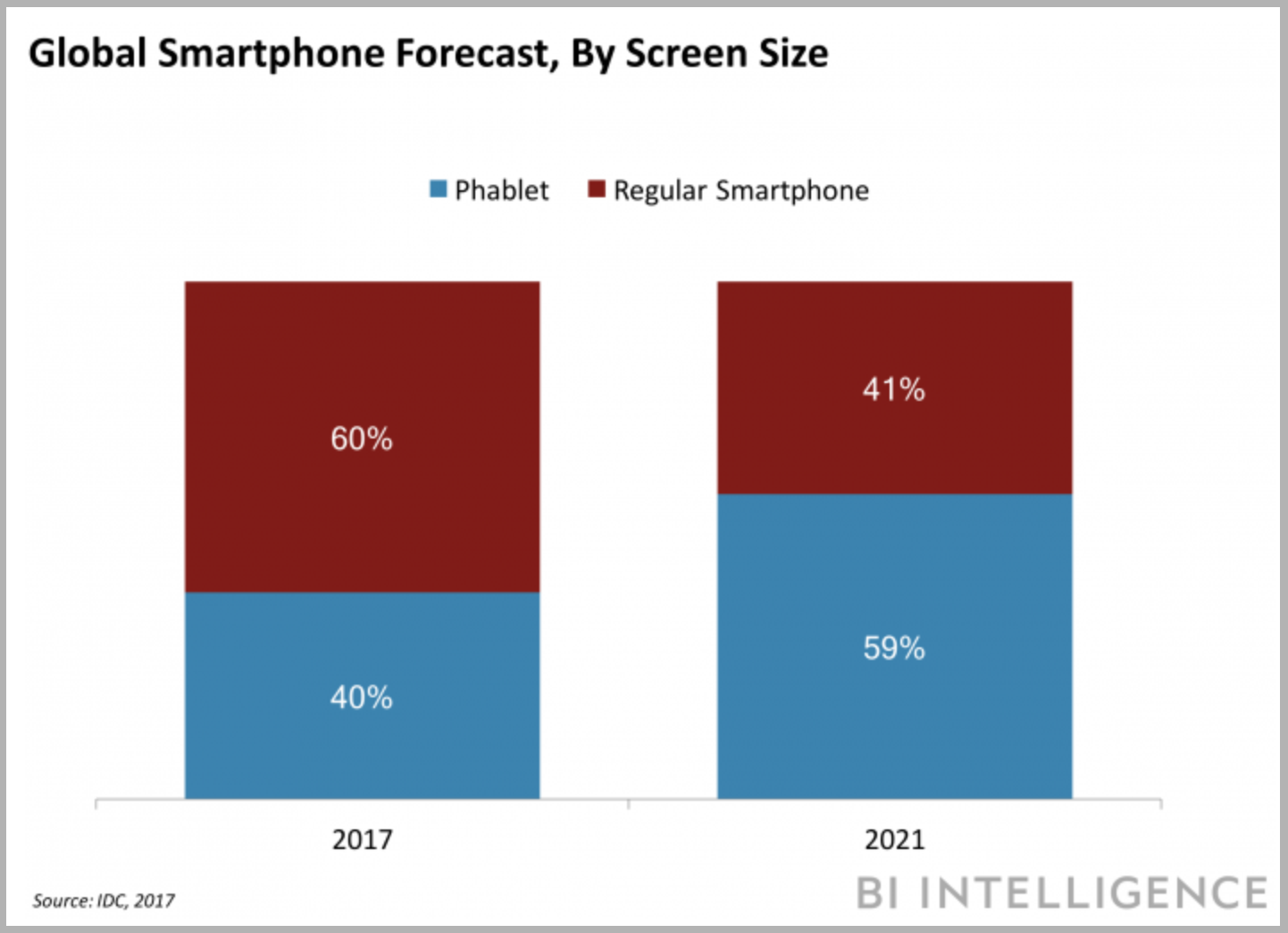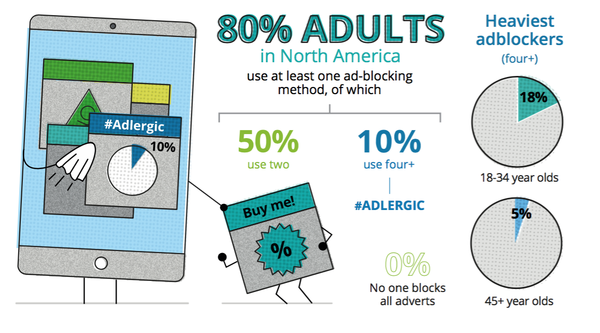The rise of phablets, a surge in mobile video traffic, consumers’ growing reliance on tech, behavior tracking reach, and more are covered in this installment of TFP’s Media Metrics roundup.
To help you keep up with trends and prepare for changes just around the corner, every quarter we compile excerpts from some key reports covering issues affecting the publishing and media industries. Here are our top picks.
 Phablets will become the most popular smartphone type by 2019 (Business Insider)
Phablets will become the most popular smartphone type by 2019 (Business Insider)
- Phablets—smartphones with a 5.5 to 7 inch screen—will account for 59% of the smartphone market by 2021, up from 40% in 2017.
- Phablets sales are expected to hit 1 billion units in 2021, reflecting a compound annual growth rate of 18%. Meanwhile, sales of traditional smartphones will drop 7.4% in the same period.
- Phablet users launch 21% more apps than those with 4-inch smartphone screens. They also use their apps longer, with a 3% to 5% higher average session length than their counterparts.
- By 2021, phablets will make up 91% of Android shipments, an increase from 75% in 2016. Large-screen iPhones, meanwhile, accounted for 41% of Apple’s shipment volume last year, and that’s expected to rise to 50% in 2018.
Video Will Make Up 75 percent of Mobile Traffic in Five Years (Recode)
- According to a report from telecommunications provider Ericsson, video will make up three quarters of all mobile traffic by 2023, up from about half today.
- Global mobile data traffic will shoot up to 110 exabytes per month by 2023—eight times the 14 exabytes used per month last year. That projection is the equivalent of 5.5 million years of streaming HD video.
- The report notes users worldwide now use on average 2.9 gigabytes of data per month, so typical data plans today are 2GB to 5GB. But unlimited data plans will likely become the norm by 2023 as usage increases to an average 17GB, it adds.
Deloitte Predicts Increased Reliance On Technology (Marketing Daily)
 According to research by Deloitte, three-quarters of users in North America use at least one form of adblocking, and about 10% use four or more forms of the technology.
According to research by Deloitte, three-quarters of users in North America use at least one form of adblocking, and about 10% use four or more forms of the technology.- A fifth of North Americans will access all their Internet data on mobile networks this year, although that figure varies greatly by geography—for example, a third of users in Brazil are now mobile only while that applies to only 10% of households in some European countries.
- The researchers project that live broadcast and events will bring in more than $545 billion in revenues in 2018. “Despite consumers’ capability to consume content on demand or attend events remotely, live consumption is thriving,” the report says.
- Willingness to pay for content is expected to increase among consumers, with more than 680 million digital subscriptions by 2020. The report says China remains the largest livestreaming market, at $4.4 billion in 2018.
79% Of Websites Link To Data, Behavior Tracking Technology (Search Marketing Daily)
- At least 79% of websites track data on Internet users’ online behavior, with 15% of all pages loaded on the Internet monitored by 10 or more trackers, research shows.
- Not surprisingly, the duopoly are among the companies with the highest data tracking reach, with Google at 60.2% and Facebook at 27.1%. Even if users don’t use Google or Facebook, the companies “have access to their data if they interact with brands that advertise through any one of their networks, such as DoubleClick,” the report explains.
- Other companies with a high data tracking ranking include comScore (11.4%), Twitter (10.5%), and Yandex (9.5%).
Streaming Hours Up Over 100% In 2017, Study Says (Digital News Daily)
- A recent report says consumers are spending more hours than ever streaming over-the-top (OTT) video, with viewing time in 2017 increasing 100% over the previous year.
- That accounts for 12.6 billion hours of OTT video streaming across 2.4 billion devices.
- According to the report, 58% of viewing takes place in North America, 21% in Europe, and 19% in Asia.
- New research shows one in three people, or 2.48 billion users, worldwide used a social network last year, a 8.7% gain over 2016.
- 74.7% of mobile Internet users worldwide accessed social media via their mobile devices last year, with 82.5% using a mobile device to visit social sites at least once a month.
- Facebook stayed in the top spot among social sites in 2017: 62.2% of users, or 1.54 billion people, visited the site at least once a month last year. About 594 million people, or a quarter of all social media users worldwide, used Instagram regularly in 2017, the report says.
Forrester: Marketers Still Struggling to Understand Mobile (Search Marketing Daily)
- Half of the respondents to a recent Forrester survey said they don’t have the resources they need for effective mobile marketing, and just 42% said their teams have the skills needed for mobile.
- Mobile also remains siloed, according to 64% of respondents, and collaboration across international divisions is “a top challenge,” the report says.
- A third of advertisers in the survey said they don’t know which specific ad formats are most effective, and they aren’t able to effectively measure return on investment.
- However, 74% expect their mobile ad budgets to increase in the next 12 months. Some 32% expect that increase to be between 15% and 30%, while 42% expect an increase of 1% to 14%.
Researchers at GeoEdge Uncover New Auto-Redirects Costing Publishers and Marketers Over $1 Billion (GlobeNewswire)
- Researchers found auto-directs represent 48% of malware, making it by far the most used “malvertising” method today.
- Mobile devices are the “vehicle of choice” (72%) for auto-redirects, according to the study.
- Losses due to auto-redirects stand at $210 million for publishers and $920 million for marketers, amounting to a total loss of $1.13 billion.
Data Spending to Hit $10 Billion this Year: IAB/DMA Report (Media Daily News)
- A new report projects companies in the U.S. will spend $10.05 billion on third-party audience data this year, and an additional $10.13 billion on solutions to support its implementation.
- Of the total, $3.5 billion will be spent on email addresses, names, street addresses, and other personally identifiable information, categorized as omnichannel. It also includes $2.9 billion for transactional data and $2 billion for digital identifiers.
- In addition, $4.2 billion is expected to go to hosting and management solutions, and $1.63 billion for analytics, modeling, and segmentation solutions.
Sales of Print Books Increased, Slightly, in 2017 (Publishers Weekly)
- In 2017, print book sales rose 1.9% compared with 2016, with a total of 687.2 million units sold.
- Sales have gone up 10.8% overall since 2013.
- Gains were greatest in the retail and club channel, with an annual unit sales increase of 3.5% in 2017. According to the report, juvenile nonfiction was the top category, up 7.8% over 2016, to 59.8 million units.
Americans Say Greater Access to News Sources Is Actually Making It Harder to Stay Informed (Nieman Lab)
- A Gallup/Knight poll found that 84% of Americans believe the media plays a critical role in democracies, but only 33% have a “very favorable” or “somewhat favorable” view of news organizations.
- Some 58% of survey respondents said the growing number of news sources makes it difficult for them to stay informed.
- Among Democrats, 54% give the news media a favorable rating, while just 15% of Republicans do.
- Overall, 45% cited “a great deal” of bias in news coverage, compared with just 25% in 1989. Fewer than half of the survey respondents said they could identify an objective source of news.
‘Fake News’: Wide Reach but Little Impact, Study Suggests (The New York Times)
- While one in four Americans saw at least one false story during the 2016 election season, a recent study found that such content was “a small fraction” of participants’ overall news exposure, regardless of political views: only 1% among Clinton supporters and 6% for Trump supporters.
- On 289 sites that demonstrated at least two false stories, about 80% of that content supported Trump, the study found.
- Those age 60 and older were more likely to visit “fake news” sites than younger news consumers.
Obsessed Much? Mobile Addiction Is Real (eMarketer)
- U.S. Internet users between 18 and 75 years old check their smartphones about 47 times per day, a survey by Deloitte and Ipsos MORI found. And younger users check their devices much more often—approximately 86 times a day, up from 82 in 2016.
- Almost nine in 10 respondents check their phones within an hour of waking up and about the same number do the same before going to bed.
- A vast majority of survey respondents said they keep their phones nearby when doing a variety of activities, including shopping (93%), spending leisure time (90%), watching TV (89%), and talking to family and friends (85%).
- Some survey respondents (47%) said they are trying to keep their smartphone usage in check by putting it away or turning it off, while 33% said they turn off notifications and 26% delete apps.
Images: Business Insider and Marketing Daily
Media Metrics is a monthly feature from Technology for Publishing, aimed at keeping you armed with the latest industry data. If you’d like to share something you’ve read, drop us a note. And keep up with the latest industry news coverage by signing up for our This Week in Publishing emails and our Publishing Innovations newsletter.
Posted by: Margot Knorr Mancini


